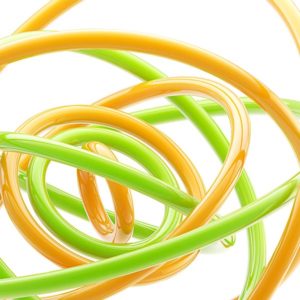
Knots affect our lives in perplexing ways. They can perform life-saving assistance, such as during rock climbing, or provide Sisyphean puzzles of entanglement. Often, knots seem to have the contrarian personality of an adolescent. They loosen and unwind when you want them to stay fastened, and inevitably form tangles of confounding complexity when you seek to avoid them. These puzzling characteristics of knots were brought to mind when I read two recent articles about the scientific investigation of knots.
Why Knots Fail
The explanation of how shoelaces come untied, published in Proceedings of the Royal Society A, was quite prevalent in the news cycle recently. After observing slow-motion video footage of the shoelaces of a runner on a treadmill, researchers were able to explain how motion affects knots and results in untied shoelaces.
First, they observed that the failure of a knot is not a gradual process, but happens abruptly over the course of only one or two strides. This is possible due to the surprising amount of force generated by the impact of one step, which this study calculated to be an average of 7 g—more than twice the g-force experienced by the Space Shuttle upon reentry into the Earth’s atmosphere.
The researchers also found that the motion of walking or running is distinctly detrimental to a shoelace knot, in a way that simply jumping up and down or swinging your legs cannot match. The experiments demonstrated that the dual forces present when walking or running were necessary to untie a shoelace. The combination of vertical impact, which loosens the knot, and horizontal inertia that pulls the laces provides the perfect storm of forces necessary to stop even the most conditioned runner in their tracks.
The differences between weak and strong knots were also examined. A weak knot, also known as a granny or false knot, twists when tightened due to the same handedness of structures called trefoils. On the other hand, a strong or square knot contains trefoils of opposite handedness which allow the knot to lie flat when tightened.
It is common knowledge that these two knots differ in performance (hence the names “weak” and strong”) and this study confirmed that weak knots had a higher failure rate in shoelaces. Researchers propose further experiments that would measure the mechanical aspects of each knot that contribute to this difference. Although retying shoelaces may seem trivial, finding fail-proof knots could have very valuable applications, such as improving surgical knots.
Staying Knot-Free
Now let’s think about knots from a different perspective. How is it that one of the most important materials in our body, DNA, remains untangled, despite being about 2 meters long and residing in a space with an approximate diameter of 6µm? Furthermore, not only are these strands of nucleic acid kept free of knots, they are organized so that particular regions that require interaction remain in the same location.
As this article in Nature explained, many scientists have centered on loop extrusion as a hypothesis to explain how chromosomes resist tangles. The process of loop extrusion involves DNA being fed through ring-shaped cohesin proteins to form loops. While there are various models, little experimental evidence is present to support any particular model. What is clear is that some mechanism of genome looping is responsible for organizing the strands of DNA and keeping certain regions separated from others.
The basic premise of loop extrusion is that DNA is fed through cohesin forming a loop, which keeps nearby areas of the chromosome in close proximity. CTCF proteins, which bind to specific sequences on DNA, interact with cohesin and determine the sections of DNA that form loops. When a CTCF protein encounters cohesion during the extrusion, the DNA bound to it will stop being fed into the loop if the CTCF is oriented in the correct direction. At the end of the process, two CTCF proteins and cohesin will be present at the base of a completed loop.
Although this idea is almost completely based on modeling with very little observed data, a technique called Hi-C has been used to reveal loops and interactions in DNA consistent with loop extrusion models. Changes in cohesion levels have been shown to affect the amount of looping, but despite this correlation, there are still questions about whether cohesin is actually responsible for propelling DNA into these loops.
Whatever the mechanism for creating and maintaining these loops, this knowledge could provide new opportunities for treating genetic disease or cancer—cohesion mutations have been found in both cases. In the case of DNA, thwarting knots and defying entropy play a crucial role in maintaining control over gene regulation.
Related Posts
Latest posts by Darcia Schweitzer (see all)
- Cytochrome P450 Inhibition: Old Drug, New Tricks - May 5, 2022
- Firefly Luciferase Sheds Light on Development of New Malaria Treatments - April 5, 2021
- How to Train Your Instrument Service Team in a Pandemic - February 1, 2021
